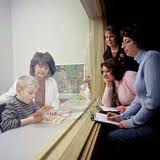Reading Recovery Awarded $2.7 Million Grant
UALR has received a $2.7 million grant through the U.S. Department of Education to expand its Reading Recovery program, a teacher training and literacy intervention education program based in the university’s College of Education.
 The university’s grant is part of a $45.5 million effort by the Department of Education to “fund what works” in education over the next five years. The “Reading Recovery: Scaling Up What Works” project is a collaboration of 15 institutions of higher education with Ohio State University as the lead institution. UALR is the only Arkansas institution to receive the funding.
The university’s grant is part of a $45.5 million effort by the Department of Education to “fund what works” in education over the next five years. The “Reading Recovery: Scaling Up What Works” project is a collaboration of 15 institutions of higher education with Ohio State University as the lead institution. UALR is the only Arkansas institution to receive the funding.
UALR College of Education Dean Angela Sewall and Dr. Linda Dorn, director of the UALR Center for Literacy in the College of Education, said the Arkansas funding will allow the university to expand the successful program to struggling schools in Arkansas.
“The goal of Reading Recovery is to reduce the number of first graders who are struggling in reading and to reduce the cost of these learners to the educational system,” Dorn said. “We are excited to have the opportunity to expand the program to more Arkansas schools.”
Reading Recovery, a program that came to the United States 25 years ago, got its start in Arkansas during the school reform movement. Arkansas business leaders during the administration of former Gov. Bill Clinton were instrumental in bringing it to the state.
Currently, the state has 14 Reading Recovery teacher leaders who are certified to train Reading Recovery teachers. In 2009-2010, 286 Reading Recovery teachers in 86 school districts provided one-to-one intervention to 2,423 first graders, plus small group intervention to 10,183 struggling readers in first to third grades. The funding will add one new Reading Recovery teacher leader and 250 new Reading Recovery teachers during a five-year period.
“There are a number of youngsters in the state who are labeled as having special education issues who in fact have no problems,” Sewall said. “They actually have literacy and verbal expression problems because of lack of resources. Identifying these students early means they can have those literacy problems corrected with the help of the specific type of reading approach or intervention they need.”
The Reading Recovery program trains reading instructors how to work with the individual needs of students.
“Some people learn by word recognition, some people learn by sounding out words, some people learn by means of context clues,” Sewall said. “Reading Recovery encompasses these techniques and more.”
Research by UALR’s program and nationwide indicates that approximately 75 percent of students who complete the program meet grade-level expectations in reading and writing. Follow-up studies indicate that most Reading Recovery students also do well on standardized tests and maintain their gains in later years.
“The research on early intervention is clear,” Dorn said. “It is much easier—and more cost effective—to prevent reading failure than to deal with the consequences of illiteracy. A first grader who works one-on-one with a Reading Recovery trained teacher for 30-minute lessons
over a 12 to 20-week period can catch up with peers and save a lifetime of learning problems.”
UALR is one of 22 university-based Reading Recovery centers in the U.S. that brings in teachers for training, but most of the direct training is in the schools.
“The program trains teachers in a clinical setting,” Dorn said. “Teachers learn by doing. They teach their students behind a one-way mirror while their colleagues observe and discuss the effectiveness of the instruction.
“It is a premier training model. If Reading Recovery were implemented in all Arkansas schools, it could change the face of literacy in our state.”
Over a five-year period, partner institutions will target 1,500 under-performing schools by training new teacher leaders who in turn will join with current teacher leaders to train 3,750 new Reading Recovery teachers. The goal of the project is to increase the achievement levels of
students in persistently low-performing schools. The grant will provide resources to cover the cost of tuition, training stipends, supplies, and travel for new educational leaders and teachers in the Reading Recovery program.
In addition to UALR and Ohio State, partner institutions include Clemson University, Georgia State University, Lesley University, National Louis University, New York University, Oakland University, Texas Women’s University, University of Connecticut, University of Kentucky,
University of Maine, University of Northern Iowa, University of South Dakota, and University of Pennsylvania.